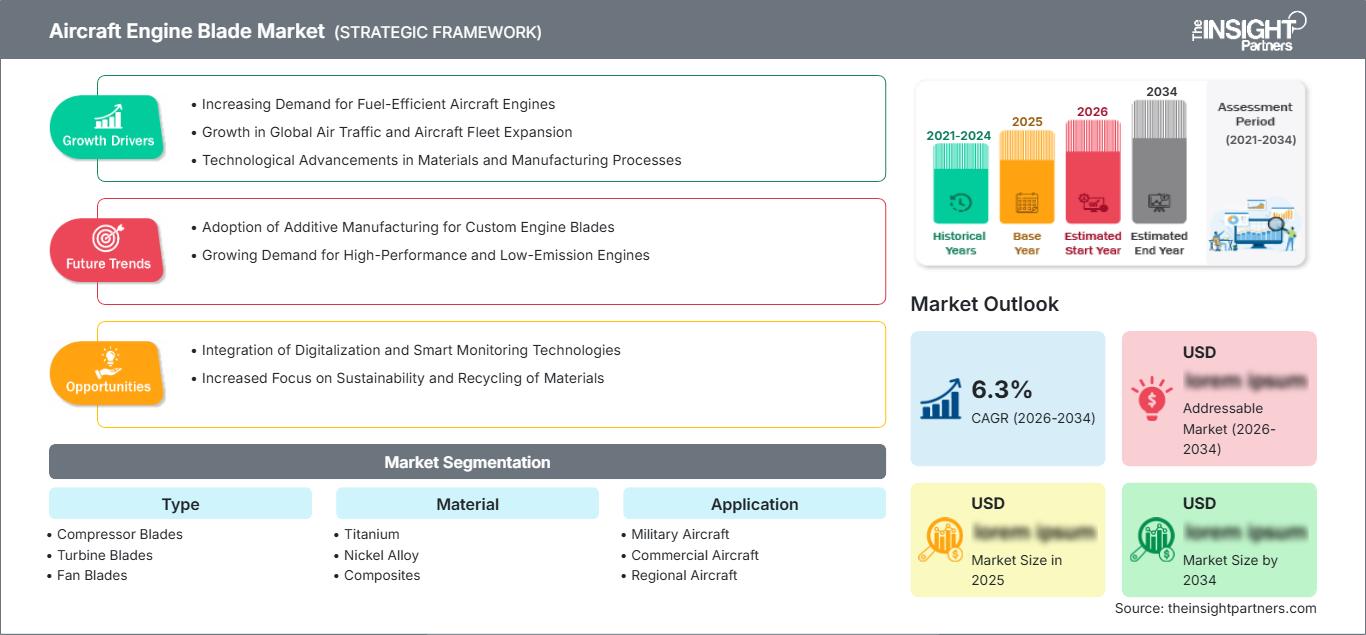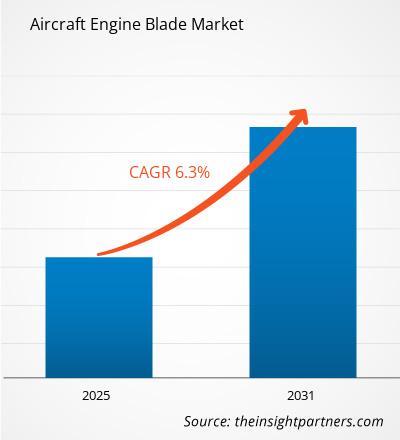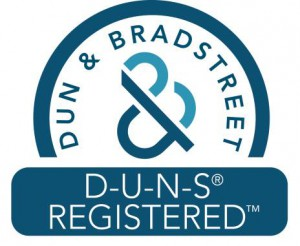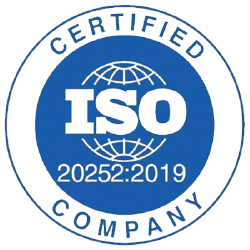Aircraft Engine Blade Market Key Players Analysis and Growth Forecast by 2034
Historic Data: 2021-2024 | Base Year: 2025 | Forecast Period: 2026-2034Coverage: Aircraft Engine Blade Market covers analysis By Blade Type (Compressor Blades, Turbine Blades, Fan Blades); Material (Titanium, Nickel Alloy, Composites, Aluminum Alloy, Others); Application (Military Aircraft, Commercial Aircraft, General Aviation) , and Geography (North America, Europe, Asia Pacific, and South and Central America)
- Report Date : Feb 2026
- Report Code : TIPRE00016918
- Category : Aerospace and Defense
- Status : Upcoming
- Available Report Formats :


- No. of Pages : 150
The Aircraft Engine Blade Market is anticipated to expand at a CAGR of 6.3% from 2026 to 2034. Market conditions continue to evolve, leading to new opportunities for stakeholders. The overall landscape reflects stable progress and long-term growth potential.
The report is segmented by Blade Type (Compressor Blades, Turbine Blades, Fan Blades); Material (Titanium, Nickel Alloy, Composites, Aluminum Alloy, Others); Application (Military Aircraft, Commercial Aircraft, Regional Aircraft, General Aviation). The global analysis is further broken-down at regional level and major countries. The Report Offers the Value in USD for the above analysis and segments.
Purpose of the Report
The report Aircraft Engine Blade Market by The Insight Partners aims to describe the present landscape and future growth, top driving factors, challenges, and opportunities. This will provide insights to various business stakeholders, such as:
- Technology Providers/Manufacturers: To understand the evolving market dynamics and know the potential growth opportunities, enabling them to make informed strategic decisions.
- Investors: To conduct a comprehensive trend analysis regarding the market growth rate, market financial projections, and opportunities that exist across the value chain.
- Regulatory bodies: To regulate policies and police activities in the market with the aim of minimizing abuse, preserving investor trust and confidence, and upholding the integrity and stability of the market.
Aircraft Engine Blade Market Segmentation Type
- Compressor Blades
- Turbine Blades
- Fan Blades
Material
- Titanium
- Nickel Alloy
- Composites
- Aluminum Alloy
- Others
Application
- Military Aircraft
- Commercial Aircraft
- Regional Aircraft
- General Aviation
Geography
- North America
- Europe
- Asia-Pacific
- South and Central America
- Middle East and Africa
You will get customization on any report - free of charge - including parts of this report, or country-level analysis, Excel Data pack, as well as avail great offers and discounts for start-ups & universities
Aircraft Engine Blade Market: Strategic Insights

-
Get Top Key Market Trends of this report.This FREE sample will include data analysis, ranging from market trends to estimates and forecasts.
Aircraft Engine Blade Market Growth Drivers
- Increasing Demand for Fuel-Efficient Aircraft Engines: The global aviation industry is continuously focused on improving fuel efficiency due to rising fuel costs and the need to reduce carbon emissions. Aircraft engine blades, particularly those used in turbine engines, are critical for improving the efficiency of these engines. Innovations in materials such as high-performance alloys, ceramic matrix composites, and advanced coatings help make engine blades more durable and capable of operating at higher temperatures, thereby increasing engine efficiency. This demand for more fuel-efficient engines directly drives the need for advanced aircraft engine blades.
- Growth in Global Air Traffic and Aircraft Fleet Expansion: As global air traffic continues to grow and airlines expand their fleets to accommodate rising passenger numbers, there is a corresponding increase in the demand for new aircraft engines and their components, including engine blades. Aircraft manufacturers, such as Boeing and Airbus, are introducing new aircraft models with more fuel-efficient engines, which require advanced engine blades to meet higher performance standards. This growing demand for both new aircraft and engine overhauls is a significant driver for the aircraft engine blade market.
- Technological Advancements in Materials and Manufacturing Processes: The aerospace sector's increasing focus on advanced materials and manufacturing processes is driving the aircraft engine blade market. New materials, such as single-crystal alloys, titanium aluminides, and advanced composite materials, offer superior strength, heat resistance, and fatigue resistance, improving the performance and lifespan of engine blades. Additionally, advancements in manufacturing technologies, like additive manufacturing (3D printing), allow for the production of more complex blade geometries and reduce material waste, driving the demand for more advanced and durable blades.
Aircraft Engine Blade Market Future Trends
- Adoption of Additive Manufacturing for Custom Engine Blades: Additive manufacturing (AM), or 3D printing, presents a significant opportunity for the aircraft engine blade market, particularly for producing complex geometries and customized parts. AM allows manufacturers to produce engine blades with intricate designs that improve airflow, reduce weight, and enhance efficiency. Additionally, it allows for on-demand production of spare parts, reducing lead times and costs. This technology is especially useful in the development of prototype blades or for low-volume, high-performance engine blade production, opening up new opportunities for companies investing in AM technology.
- Growing Demand for High-Performance and Low-Emission Engines: As environmental concerns rise, there is growing pressure on the aviation industry to reduce emissions. This creates opportunities for the aircraft engine blade market to develop components for next-generation, low-emission, and high-performance engines. Engine manufacturers are increasingly focused on designing engines that can operate at higher temperatures and pressures to improve efficiency and reduce emissions. Aircraft engine blades made from advanced materials capable of withstanding these extreme conditions will be in high demand as the market shifts toward environmentally friendly aviation technologies.
Aircraft Engine Blade Market Opportunities
- Integration of Digitalization and Smart Monitoring Technologies: Another key trend in the market is the integration of digitalization and smart monitoring technologies for engine blades. With advancements in sensors, Internet of Things (IoT) connectivity, and data analytics, manufacturers are developing blades that can monitor their own health in real-time. These Report Scope
Aircraft Engine Blade Market Regional Insights
The regional trends and factors influencing the Aircraft Engine Blade Market throughout the forecast period have been thoroughly explained by the analysts at The Insight Partners. This section also discusses Aircraft Engine Blade Market segments and geography across North America, Europe, Asia Pacific, Middle East and Africa, and South and Central America.
Aircraft Engine Blade Market Report Scope
By Material- Titanium
- Nickel Alloy
- Composites
- Aluminum Alloy
- Others
- Military Aircraft
- Commercial Aircraft
- Regional Aircraft
- General Aviation
- UK
- Germany
- France
- Russia
- Italy
- Rest of Europe
- China
- India
- Japan
- Australia
- Rest of Asia-Pacific
- Brazil
- Argentina
- Rest of South and Central America
- South Africa
- Saudi Arabia
- UAE
- Rest of Middle East and Africa
Report Attribute Details Market size in 2025 US$ XX Million Market Size by 2034 US$ XX Million Global CAGR (2026 - 2034) 6.3% Historical Data 2021-2024 Forecast period 2026-2034 Segments Covered By Type - Compressor Blades
- Turbine Blades
- Fan Blades
Regions and Countries Covered North America - US
- Canada
- Mexico
Market leaders and key company profiles - Albany International Corp
- Collins Aerospace, a Raytheon Technologies company
- Doncasters Group
- Farinia Group
- GE Aviation
- GKN Aerospace Services Limited
- IHI Corporation
- MTU Aero Engines AG
- Rolls-Royce plc
Aircraft Engine Blade Market Players Density: Understanding Its Impact on Business Dynamics
The Aircraft Engine Blade Market is growing rapidly, driven by increasing end-user demand due to factors such as evolving consumer preferences, technological advancements, and greater awareness of the product's benefits. As demand rises, businesses are expanding their offerings, innovating to meet consumer needs, and capitalizing on emerging trends, which further fuels market growth.

- Get the Aircraft Engine Blade Market top key players overview
Frequently Asked Questions
What are the options available for the customization of this report?
What are the deliverable formats of the aircraft engine blade market report?
What are the future trends of the aircraft engine blade market?
1. Introduction of Next-Gen Aircraft Models
What are the driving factors impacting the aircraft engine blade market?
1. Increasing Narrow-Body Commercial Aircraft Orders and Deliveries
2. Procurement of Military Aircraft
What is the expected CAGR of the Aircraft Engine Blade Market?
Naveen is an experienced market research and consulting professional with over 9 years of expertise across custom, syndicated, and consulting projects. Currently serving as Associate Vice President, he has successfully managed stakeholders across the project value chain and has authored over 100 research reports and 30+ consulting assignments. His work spans across industrial and government projects, contributing significantly to client success and data-driven decision-making.
Naveen holds an Engineering degree in Electronics & Communication from VTU, Karnataka, and an MBA in Marketing & Operations from Manipal University. He has been an active IEEE member for 9 years, participating in conferences, technical symposiums, and volunteering at both section and regional levels. Prior to his current role, he worked as an Associate Strategic Consultant at IndustryARC and as an Industrial Server Consultant at Hewlett Packard (HP Global).
- Historical Analysis (2 Years), Base Year, Forecast (7 Years) with CAGR
- PEST and SWOT Analysis
- Market Size Value / Volume - Global, Regional, Country
- Industry and Competitive Landscape
- Excel Dataset
Testimonials
The Insight Partners' SCADA System Market report is comprehensive, with valuable insights on current trends and future forecasts. The team was highly professional, responsive, and supportive throughout. We are very satisfied and highly recommend their services.
RAN KEDEM Partner, Reali Technologies LTDsI requested a report on a very specific software market and the team produced the report in a few days. The information was very relevant and well presented. I then requested some changes and additions to the report. The team was again very responsive and I got the final report in less than a week.
JEAN-HERVE JENN Chairman, Future AnalyticaWe worked with The Insight Partners for an important market study and forecast. They gave us clear insights into opportunities and risks, which helped shape our plans. Their research was easy to use and based on solid data. It helped us make smart, confident decisions. We highly recommend them.
PIYUSH NAGPAL Sr. Vice President, High Beam GlobalThe Insight Partners delivered insightful, well-structured market research with strong domain expertise. Their team was professional and responsive throughout. The user-friendly website made accessing industry reports seamless. We highly recommend them for reliable, high-quality research services
YUKIHIKO ADACHI CEO, Deep Blue, LLC.This is the first time I have purchased a market report from The Insight Partners.While I was unsure at first, I visited their web site and felt more comfortable to take the risk and purchase a market report.I am completely satisfied with the quality of the report and customer service. I had several questions and comments with the initial report, but after a couple of dialogs over email with their analyst I believe I have a report that I can use as input to our strategic planning process.Thank you so much for taking the extra time and making this a positive experience.I will definitely recommend your service to others and you will be my first call when we need further market data.
JOHN SUZUKI President and Chief Executive Officer, Board Director, BK TechnologiesI wish to appreciate your support and the professionalism you displayed in the course of attending to my request for information regarding to infectious disease IVD market in Nigeria. I appreciate your patience, your guidance, and the fact that you were willing to offer a discount, which eventually made it possible for us to close a deal. I look forward to engaging The Insight Partners in the future, all thanks to the impression you have created in me as a result of this first encounter.
DR CHIJIOKE ONYIA MANAGING DIRECTOR, PineCrest Healthcare Ltd.Reason to Buy
- Informed Decision-Making
- Understanding Market Dynamics
- Competitive Analysis
- Identifying Emerging Markets
- Customer Insights
- Market Forecasts
- Risk Mitigation
- Boosting Operational Efficiency
- Strategic Planning
- Investment Justification
- Tracking Industry Innovations
- Aligning with Regulatory Trends




















 Get Free Sample For
Get Free Sample For